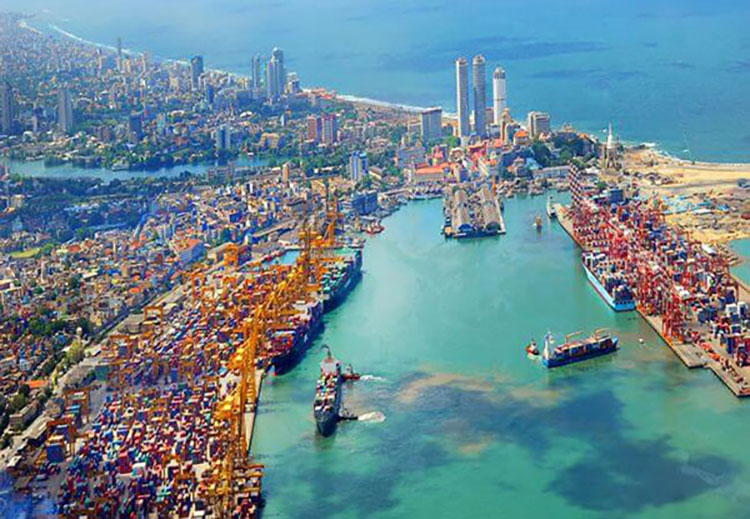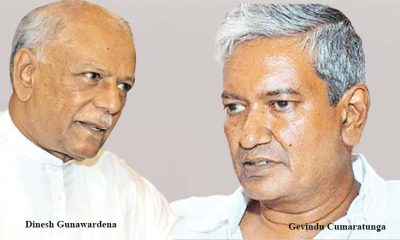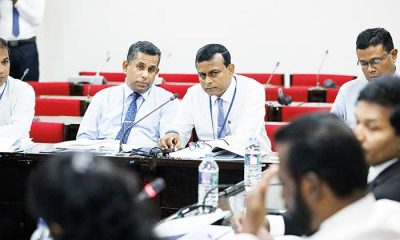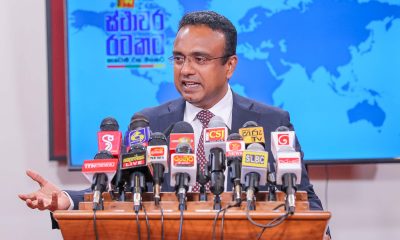Business
Charting Sri Lanka’s economic future: Current challenges and strategies for resilient growth

By Rasith Wickremasinghe COYLE Chairman
The Sri Lankan economy currently grapples with the significant challenges presented by a complex financial situation unfolding in unprecedented ways. As the country tackles the intricacies of this economic turmoil to overcome fiscal obstacles, there is a prevailing sense of concern among the populace. Against this backdrop, the nation contends with politically motivated decision-making that bears the marks of a presidential election at the end of 2024.
Despite these existing realities, we remain optimistic about the rising potential through collective efforts and shared objectives driven by the nation’s private sector, aiming to revitalize the economy. In the present circumstances, positive indicators emerge as macroeconomic policy reforms start showing concrete outcomes, signalling a promising phase of stabilization in Sri Lanka’s economic landscape. Nonetheless, the path to recovery and inclusive growth relies on maintaining the ongoing momentum of these reforms.
Looking at the recent upgrade of Sri Lanka’s local currency rating from selective default (SD) to CCC+/C by S&P Global Ratings, there is a reflection of a more optimistic view of the country’s solvency. This upgrade follows the finalization of a domestic debt restructure, including collaboration with superannuation funds (EPF/ETF) and the Central Bank. https://www.fitchratings.com/research/sovereigns/fitch-upgrades-sri-lanka-long-term-local-currency-idr-to-ccc-28-09-2023
The completion of the first IMF review under the 48-month Extended Fund Facility marks a significant milestone, unlocking access to SDR 254 million (about US$337 million) to support the country’s economic policies and reforms. Notably, Sri Lanka’s performance under the program has been deemed satisfactory, with the majority of performance criteria and indicative targets met by the end of June.
The publication of the Governance Diagnostic Report showcases a pioneering step, positioning Sri Lanka as the first country in Asia to undergo this IMF exercise. The commendable progress made by the authorities in restoring debt sustainability, raising revenue, and ensuring financial stability reflects a positive trajectory. Moving forward, a strong commitment to improving governance and protecting the welfare of the vulnerable will be crucial, laying the foundation for a resilient and prosperous economic future.
Examining Sri Lanka’s net general government debt, which currently exceeds 100% of GDP and is projected to persist until at least 2028, there are challenges ahead. Addressing concerns about long-term sustainability, potential positive shifts can be driven by factors such as nominal GDP growth, successful fiscal consolidation, increased revenue generation, current interest rates, and the positive impacts of future restructuring efforts. By navigating these aspects effectively, Sri Lanka has the potential to enhance its fiscal outlook and achieve more favourable outcomes in the coming years. https://www.fitchratings.com/research/sovereigns/fitch-upgrades-sri-lanka-long-term-local-currency-idr-to-ccc-28-09-2023
It’s noteworthy that Sri Lanka’s Budget for 2024 presents ambitious targets, though they pose challenges, particularly with the projected wider fiscal deficit of 9.1% of GDP. The government’s focus on achieving a primary surplus, excluding bank recapitalization, aligns with the IMF’s projections. However, the expenditure target of 22.2% of GDP exceeds the IMF’s envisioned 19.7%. While this discrepancy may raise questions, it also reflects a commitment to ambitious goals, and successful implementation could enhance the budget’s long-term viability and effectiveness. https://island.lk/sri-lankas-ambitious-budget-agenda-faces-high-implementation-risks-fitch-ratings/
Fitch Ratings has already expressed concerns about the government’s plan to reach its revenue target by 2024. Sri Lanka has a history of not meeting fiscal goals, with revenue collection falling short by 29% in the first nine months of 2023. Recently, the government has planned a revenue increase of nearly 45% in 2024, with a confirmed 3-percentage-point rise in the value-added tax to 18%.
We believe as far as tax revenue is concerned, widening the tax net or the number of taxpayers in the country is more critical than raising the percentage values. Only as little as 2.6% of Sri Lanka’s total workforce of 4.64 million is subjected to the PAYE income tax. Nearly half of the labour force receives less than Rs.30,000 monthly salary, while 3.91 million families, out of 5.8 million families, are seeking state assistance to continue their livelihoods. In 2021, there were about 105,000 registered companies, and 60,721 had income tax files, from which 82 per cent of the corporate income taxes were paid by 342 companies. https://economynext.com/sri-lanka-only-has-137-persons-who-paid-income-taxes-of-rs5mn-or-more-legislator-100108/#:~:text=Sri%20Lanka%20in%202021%20had,were%20paid%20by%20342%20companies
What baffles us mostly is the number of tax files reported by the inland revenue which is recorded to be only 500,000 as per the Commissioner Association Inland Revenue department. https://www.newsfirst.lk/2023/07/27/tott-only-500-000-tax-files-in-sri-lanka-president-commissioner-association-27-07-2023/ . If the recorded number of tax files is only 500,000 out of the 5.8 Million families in Sri Lanka, we must ask the question of what has happened to the rest of the taxpayers.
Several businesses in Sri Lanka, whether small, medium, or large, conduct their transactions mainly through cash. Despite how much they earn, there can be several loopholes they can harness for tax evasion. Even though it is apparent in many ways, there is little to no step taken forward to curb the issue owing to political gains or the mass displeasures that could arise curbing the future of many political affiliates in the decision-making process.
Concurrently, the growing wealth gap between the affluent and less privileged segments of the population is reaching alarming levels, compelling numerous skilled professionals to seek better opportunities abroad.
It’s not just the taxation system; the government’s inability to overhaul unprofitable state-owned enterprises (SOEs) adds to the discontent. The weight of these financially struggling entities falls disproportionately on a limited number of taxpayers, causing widespread chaos that ripples through the entire system. This, in turn, has a cascading impact on the economy and Sri Lankan society. An aspect often overlooked by many governing parties owing to their political future. Given that a significant portion of those affected by these restructuring efforts comprises a substantial voter base and influential circles in the country, there appears to be a reluctance among decision-makers to take the necessary corrective actions.
One of the contributing factors for the IMF to provide the second tranche was the promise to reduce the commercial bank interest rates to single digits, which is yet to be done. Even though the president and the CBSL have requested the above, several parties have been insensitive about the situation and requests. As COYLE, we emphasize the importance of expanding the tax potential net and then further tracking the registered yet inactive member mass. However, we can observe, that the government is now distracted to a path more concerned with securing votes for the upcoming elections as opposed to the earlier economic revival path, which has diminished its momentum from the critical pace of decision-making on SOE restructuring.
This will bring us to COYLE’s point of view on how we can set further to solve the foreign currency deficit by adopting different and dynamic strategies. At COYLE, we believe Sri Lanka must look at foreign direct investments with changing state policy decisions to have a more attractive and investor-friendly outlook to attract numerous investors from booming industries. We urge the Parliamentary Select Committee on Ease of Doing Business to reactivate and pursue proactive steps towards ensuring FDIs are secure in the country without further delay.
Business
Grand Leisure Resort brings luxury senior care to Negombo

Grand Leisure Care and Wellness Resort has officially opened in Kochchikade, Negombo, introducing a resort-style senior living facility designed to international standards. Offering a blend of comfort, medical care, and wellness, the facility features private rooms with bathrooms, pantries, and modern living spaces. With 24/7 medical staff, wellness programmes, and family accommodation options, Grand Leisure caters to both independent and dependent seniors. The resort includes gardens, entertainment facilities, and high-speed internet to support residents’ well-being and connectivity. Positioned as a high-quality alternative to traditional elderly homes, it is open for short-term recovery or long-term stays, said a release.
Business
COYLE welcomes new chairman Manjula Wijesundara

The Chamber of Lankan Entrepreneurs (COYLE) last week announced the appointment of Mr. Manjula Wijesundara as its new Chairman for the year 2025/26. A COYLE news release described him as a “respected entrepreneur and passionate advocate for business-led development” and said he steps into leadership with a bold theme that reflects the needs of the hour—”A Year of International Growth.”
With the global economy undergoing profound shifts, the appointment marks a timely change in COYLE’s strategic focus, the release said.
In his inaugural remarks, the new Chairman articulated a vision for strengthening Sri Lanka’s economic resilience through robust international engagement and enhanced global market access for Sri Lankan businesses. His message was clear: sustainable economic recovery will come from expanding the nation’s presence beyond its borders.
“As Sri Lankan entrepreneurs, we must look outward and act with purpose. The next phase of our growth lies in our ability to compete, collaborate, and lead in international markets. This year will be about building bridges—with policymakers, global partners, and emerging economies—to position Sri Lanka as a trusted trade and investment partner,” Wijesundara stated.
Under his leadership, COYLE will actively pursue stronger relationships with international chambers, diplomatic missions, and trade bodies, laying the groundwork for more meaningful bilateral and multilateral cooperation. The Chamber’s focus will be to support and amplify the voice of Sri Lankan entrepreneurs globally—especially in sectors such as apparel, rubber, tea, ICT, and manufacturing, which continue to be among the country’s highest foreign exchange earners.
Wijesundara believes that strong international relations not only open new doors for exports but also attract critical investments and partnerships needed to modernise Sri Lanka’s industries and infrastructure. “In an interconnected world, diplomacy and business must go hand in hand. Our vision is to be a trusted ally in economic diplomacy,” he noted.
As part of this agenda, COYLE is preparing to lead a series of structured engagements with foreign policymakers and trade delegations. These efforts are aimed at helping Sri Lankan businesses overcome barriers to market entry, navigate evolving regulatory frameworks, and build long-term partnerships across key regions including South Asia, the Middle East, East Asia, and Europe.
By taking a proactive approach, the Chamber hopes to influence international trade conversations and ensure that Sri Lanka remains competitive in an increasingly protectionist global environment. COYLE also aims to foster stronger diaspora business linkages that could be leveraged to expand the country’s export footprint.
Business
Dialog Axiata Connects Sri Lanka to the World with the India-Asia Xpress Subsea Cable Strengthening Redundancy and Global Data Connectivity

Dialog Axiata PLC, Sri Lanka’s #1 connectivity provider, announced the launch of the IAX (India Asia Xpress) submarine cable system—a significant investment aimed at bolstering Sri Lanka’s international network and future-proofing the country’s digital infrastructure. Consequently, Dialog’s total investments in international connectivity infrastructure surpassed USD 100 million.
This milestone was achieved through collaborative efforts with a consortium of regional telco partners and global hyperscalers, led by Reliance Jio—underscoring Dialog’s commitment to building strategic alliances that drive technological advancement and innovation.
The IAX cable system significantly enhances Sri Lanka’s global connectivity by providing high-speed, high-capacity bandwidth, catering to the growing demands of 5G, AI, and other data-intensive applications. Designed with cutting-edge technology, the IAX cable integrates seamlessly into Dialog’s existing subsea infrastructure, ensuring scalable and efficient data transmission between major global content hubs in Mumbai, Chennai, and Singapore. This development further cements Sri Lanka’s role as a key player in the region’s digital transformation.
To commemorate this strategic milestone, Dialog hosted an official launch event at the Dialog IAX Submarine Cable Landing Station in Matara. The event was graced by several distinguished dignitaries, including His Excellency Badli Hisham Adam, High Commissioner of Malaysia; Mr. Harvinder Singh, Consul General of India; Mr. Vivek Sood, Group Chief Executive Officer and Managing Director of Axiata Group Berhad; and Supun Weerasinghe, Director / Group Chief Executive of Dialog Axiata PLC, along with other representatives from Dialog.

Launch of the IAX Submarine Cable (photographed from left to right): Mr. Lasantha Theverapperuma, Group Chief Marketing Officer, Dialog Axiata PLC; Ms. Lim Li San, Group Chief Operating Officer, Dialog Axiata PLC; Mr. Ranga Kariyawasam, Group Chief Technology Officer, Dialog Axiata PLC; Mr. Harvinder Singh, Consul General of India; His Excellency Badli Hisham Adam, High Commissioner of Malaysia; Mr. Vivek Sood, Group Chief Executive Officer and Managing Director, Axiata Group Berhad; and Mr. Supun Weerasinghe, Director and Group Chief Executive, Dialog Axiata PLC.
The integration of the IAX cable reinforces Sri Lanka’s digital infrastructure with enhanced resilience and redundancy. By complementing the existing BBG (Bay of Bengal Gateway) and MSC (Maldives Sri Lanka Cable) systems, the IAX cable strengthens network reliability, mitigating risks associated with single points of failure. Dialog’s advanced Cable Landing Stations in Matara and Mount Lavinia ensure seamless, uninterrupted connectivity, offering businesses and consumers a more secure and robust digital experience.
Supun Weerasinghe, Director / Group Chief Executive of Dialog Axiata PLC said, “We are pleased to strengthen Sri Lanka’s digital backbone with the launch of the IAX submarine cable, made possible through collaboration with our valued global partners. This investment reinforces our commitment to empowering Sri Lankan lives and enterprises with world-class infrastructure, ensuring the nation stays ahead in an increasingly digital world. By improving network reliability and expanding capacity, we are working towards a more resilient and inclusive digital ecosystem.”
As a key player in the region’s connectivity landscape, Dialog continues to drive Sri Lanka’s position as a critical hub for global communications infrastructure. Through continuous investment in cutting-edge network solutions and strategic partnerships, Dialog is shaping the future of digital connectivity, empowering enterprises and consumers with world-class infrastructure that supports economic growth and technological innovation.
-

 Business5 days ago
Business5 days agoAitken Spence Travels continues its leadership as the only Travelife-Certified DMC in Sri Lanka
-

 Latest News4 days ago
Latest News4 days agoNPP win Maharagama Urban Council
-

 Business5 days ago
Business5 days agoLinearSix and InsureMO® expand partnership
-

 Business3 days ago
Business3 days agoJohn Keells Properties and MullenLowe unveil “Minutes Away”
-

 Foreign News1 day ago
Foreign News1 day agoMexico sues Google over ‘Gulf of America’ name change
-

 Business4 days ago
Business4 days agoNDB Bank partners with Bishop’s College to launch NDB Pixel awareness
-

 Sports4 days ago
Sports4 days agoDamsiluni, Buwindu win Under 14 tennis titles
-

 Business4 days ago
Business4 days agoHayleys debenture issue oversubscribed on opening day























